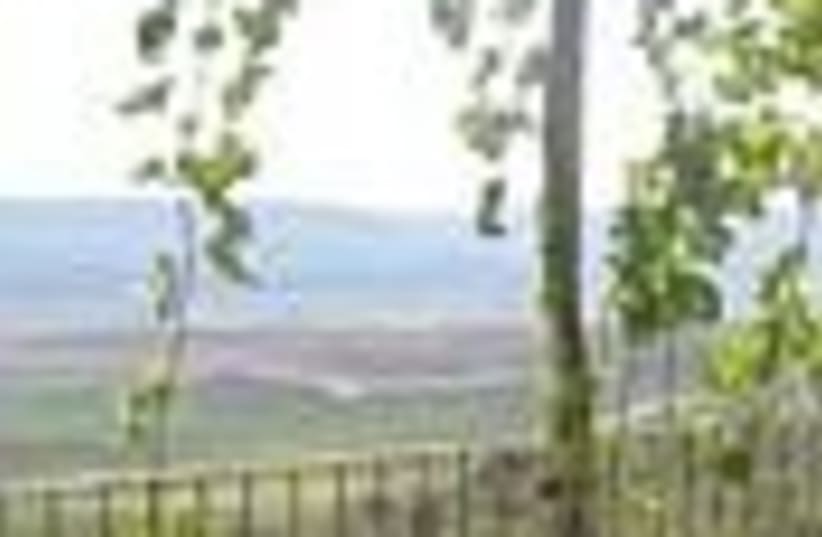Wine in Lebanon - the art of improvisation
Cabernet Sauvignon, Syrah, Merlot, Chardonnay and Muscat Petit Grains are just a few of the grape varieties imported from France.
By ROMAN LEDERER / THE MEDIA LINE NEWS AGENCY
Fabrice Guibertau holds a handful of fresh soil to his nose and takes a deep breath. "The ground here is just fantastic," he says, as the soil glides through his fingers.
Guibertau is an enologist (someone who studies wine and the making of wine) at Château Kefraya, one of Lebanon's largest wineries. Behind the Frenchman's back the slopes of the Lebanon mountain range rise up to the sky; in front of him some 100 cultivated acres stretch into the distance.
The crop area lies in the southern part of Lebanon's Bekaa Valley, the breadbasket of the country since Roman times. At the same time, it's the stronghold of Hizbullah, the Shi'ite "Party of God," led by general secretary Sheikh Hassan Nasrallah, whose followers strictly abstain from drinking alcohol.
But from Baalbek north of the Bekaa, where most of Hizbullah's followers live, to Kefraya, it's around 60 kilometers, and the workers in the vineyards are Muslim as well as Christian.
The cypresses on top of the hill, on which the little castle of Château Kefraya's founder Michel de Bustros sits, give the area a sense of Tuscany.
De Bustros started selling wine here in 1979, in the middle of the civil war.
"I fulfilled a dream for myself," the 79year-old businessman says.
The castle's salonis covered with awards for the best Kefraya wines. Just last year, the "Château Kefraya 2002" won the gold medal at the Concours Mondial de Bruxelles. Years ago, wine-pope Robert Parker in The Advocate rated Kefraya's Cuvée Prestige "Comte de M," 91 out of 100 points.
"We only produce mixtures of different grape varieties," de Bustros says about his wines, which always sport labels showing paintings by female Lebanese artists.
Cabernet Sauvignon, Syrah, Merlot, Chardonnay and Muscat Petit Grains are just a few of the grape varieties imported from France.
"Just as artists compose their pictures, we compose our wines, since its production is an art as well," de Bustros says proudly.
Winemaking is an art with a long tradition in Lebanon. Already in the second century CE, the Romans erected a temple in Baalbek to honor the wine god Bacchus. But the history of winemaking is even older.
Five thousand year old grapes were discovered at excavations in the port town of Byblos, brought to the Levant by Phoenician merchants who exported them from the Caucasus and Anatolia. In the Middle Ages, Venetian merchants exported wines from Tyre and Saida to Europe.
Following the Islamic conquests, though, vineyard cultivation changed in the land of the cedars. Monks in Christian monasteries on the western fringes of the Bekaa Valley continued the Roman tradition. The best known of these wines is Ksara, named after a crusader castle, and bought in 1857 from a handful of Jesuits. Last summer, its 150th anniversary was celebrated.
Kefraya and Ksara together share about 70 percent of the Lebanese market. Exports are rising, and in countries such as France, Lebanese wines have a long tradition.
Thus, even in times of internal crisis, winemaking in Lebanon has stayed true to its history of success and turmoil, just like the history of the country itself.
A quarter century ago, in June 1982, IDF troops moved into the Bekaa Valley just after Syrian positions north of Kefraya had been bombed. De Bustros remembers those stormy days well.
"The Israeli soldiers erected four camps on our vineyards, and the battles against the Syrians took place just around it," he recalls.
The quality of the wines apparently didn't suffer: the vintage of 1982 won the silver medal at the competition of BlayeBourg in Bordeaux - the first of 200 awards over the decades to follow.
"Nothing can stop the Lebanese," de Bustros says with a smile, as we sit in the restaurant Dionysos, which belongs to the property.
In 1987, only eight years after having founded the estate, he started exporting, despite all the difficulties of a land at war.
During Israel's siege on Beirut in 1982, for example, when transport from the capital to the Bekaa Valley was not possible, he shipped corks and bottles via boat from Jounieh to Saida, from where they could be brought over the Shouf Mountains to Kefraya. This was an art of improvisation, making the export of 15,000 bottles possible.
Today, it's one million bottles a year to 35 countries worldwide.
if(catID != 151){
var cont = `Take Israel home with the new
Jerusalem Post Store
Shop now >>
`;
document.getElementById("linkPremium").innerHTML = cont;
var divWithLink = document.getElementById("premium-link");
if(divWithLink !== null && divWithLink !== 'undefined')
{
divWithLink.style.border = "solid 1px #cb0f3e";
divWithLink.style.textAlign = "center";
divWithLink.style.marginBottom = "40px";
divWithLink.style.marginTop = "40px";
divWithLink.style.width = "728px";
divWithLink.style.backgroundColor = "#3c4860";
divWithLink.style.color = "#ffffff";
}
}
(function (v, i){
});

